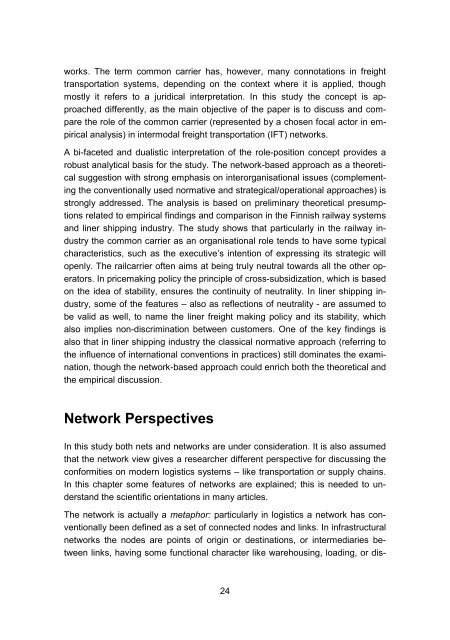849954 sisus
849954 sisus
849954 sisus
Create successful ePaper yourself
Turn your PDF publications into a flip-book with our unique Google optimized e-Paper software.
works. The term common carrier has, however, many connotations in freight<br />
transportation systems, depending on the context where it is applied, though<br />
mostly it refers to a juridical interpretation. In this study the concept is approached<br />
differently, as the main objective of the paper is to discuss and compare<br />
the role of the common carrier (represented by a chosen focal actor in empirical<br />
analysis) in intermodal freight transportation (IFT) networks.<br />
A bi-faceted and dualistic interpretation of the role-position concept provides a<br />
robust analytical basis for the study. The network-based approach as a theoretical<br />
suggestion with strong emphasis on interorganisational issues (complementing<br />
the conventionally used normative and strategical/operational approaches) is<br />
strongly addressed. The analysis is based on preliminary theoretical presumptions<br />
related to empirical findings and comparison in the Finnish railway systems<br />
and liner shipping industry. The study shows that particularly in the railway industry<br />
the common carrier as an organisational role tends to have some typical<br />
characteristics, such as the executive’s intention of expressing its strategic will<br />
openly. The railcarrier often aims at being truly neutral towards all the other operators.<br />
In pricemaking policy the principle of cross-subsidization, which is based<br />
on the idea of stability, ensures the continuity of neutrality. In liner shipping industry,<br />
some of the features – also as reflections of neutrality - are assumed to<br />
be valid as well, to name the liner freight making policy and its stability, which<br />
also implies non-discrimination between customers. One of the key findings is<br />
also that in liner shipping industry the classical normative approach (referring to<br />
the influence of international conventions in practices) still dominates the examination,<br />
though the network-based approach could enrich both the theoretical and<br />
the empirical discussion.<br />
Network Perspectives<br />
In this study both nets and networks are under consideration. It is also assumed<br />
that the network view gives a researcher different perspective for discussing the<br />
conformities on modern logistics systems – like transportation or supply chains.<br />
In this chapter some features of networks are explained; this is needed to understand<br />
the scientific orientations in many articles.<br />
The network is actually a metaphor: particularly in logistics a network has conventionally<br />
been defined as a set of connected nodes and links. In infrastructural<br />
networks the nodes are points of origin or destinations, or intermediaries between<br />
links, having some functional character like warehousing, loading, or dis-<br />
24








